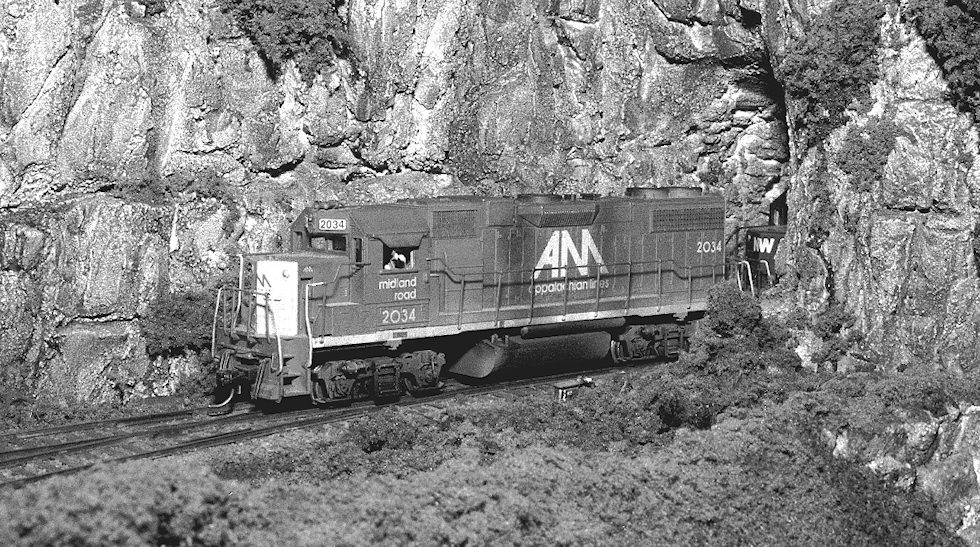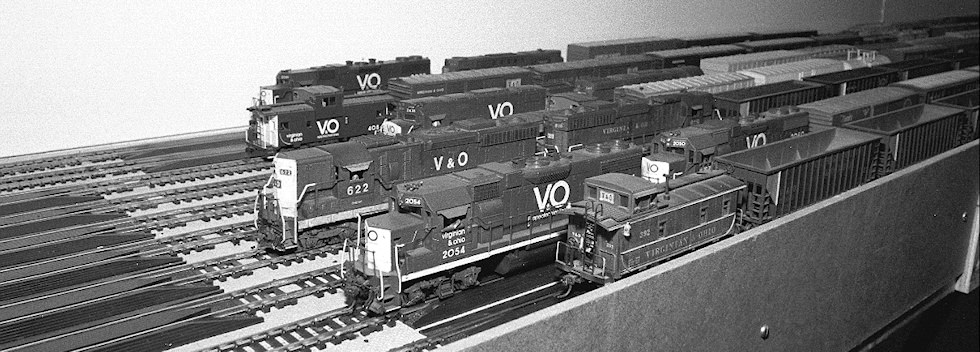Photos by Richard Schumacher
The best sort of layout, from an operator’s point of view, is point to point with staging at both ends and additional staging at one or more intermediate locations. This provides a “beyond the basement” railroad. It fixes the layout as a piece of a larger railroad. In St. Louis where I live, I see a number of different trains going to and from the yards. Many of those trains cross the MacArthur Bridge, coming from somewhere to the east of my vantage point. They enter the various yards around town and are broken up, sorted, and sent along to either another yard or the customer.
As a frequent train rider from St. Louis to Kansas City, I know how the trains are run between those points. I have traveled the Sedalia Sub a number of times and I know the route from Jefferson City well. But I am not as familiar with those points of the old MoPac west of Kansas City since I have not viewed those. I have read about them, but I do not have the same feel that I do for the stretch of track from St. Louis to Kansas City. It should be the same on our railroads. There should be a feel that we are looking at a stretch of railroad. Trains enter from one direction, travel over a stretch we know, and exit in another direction continuing the journey. Hidden staging serves as the place from which the train came and the place where it goes after it leaves our empire.

Midland Road and N&W units lead the way on a run-through train with trackage rights on the Virginian & Ohio mainline. This train traveled between hidden staging at one end of the layout, to hidden staging past the Midland Road junction.
Our model railroads are only a “snapshot” of a total system. No one has the space to model an entire railroad (unless they are modeling a small branch line or other similar operation, and even these did not exist in isolation from other railroads). Railroads are dependent on interchange with other railroads. The question is how to model the areas beyond our railroad, and the areas where other railroads interchange with ours.
One of the underused resources in the operator’s bag of tricks is the use of staging. With this tool, a modeler can simulate bridge traffic, run throughs, junctions, and interchanges. Each of these can add interest and operational possibilities. Successfully done, hidden staging can give this feel to provide fun and enhance operations.
One type of hidden staging is a short hidden siding that leads to a junction with interchange. A train from an interchange partner railroad can be hidden and then brought out at a designated time to drop off cars and pick up others. After the train has completed its switching chores, it can return to the hidden siding. This is very easy to model. It requires the investment of one engine, some cars, and perhaps a caboose. This train creates a reason for another train to arrive at the interchange and drop off and pickup cars. In addition, whenever either train is at the interchange, it will slow down operations on the main. Finally, it also generates traffic which will have to go to a yard and be sorted for delivery to a business on your layout or for a train headed off the layout (into another staging area).
Photo: A Midland Road coal train emerges from hidden staging at a junction along the main of the Virginian & Ohio.
Staging found along the railroad, but not at the ends, may also simulate a junction to another division providing additional traffic. The operational possibilities are amazing. Even if you do not have the space for a full train to interchange, one may be simulated through an electronic circuit that “flips a coin” as your trains approach the junction crossing. The circuit could set the crossing to red, indicating to your crew that the crossing is occupied or still fouled by the other railroad’s train, or it could set the signals to green indicating that the crossing is vacant.
Another type of staging is a hidden track from which a train is run into a yard. The yard can be nearby or some distance from the hidden track. This track represents either another railroad which has running rights into your yard, or another division of your railroad which connects with your “snapshot”. You could have the engines of a neighboring favorite railroad make an appearance on your railroad, and hopefully quench your thirst for that other paint scheme. Moreover, this provides for another train to run and mix with your own. It adds cars which must be switched and sent to the proper location (either at an industry or to a hidden staging yard). Don’t forget that the train must leave the yard with other cars and return to either its own railroad or its own division.
A railroad with staging at each end can represent a piece of a railroad with extensions beyond what is modeled. Trains may come out of hidden staging and run immediately into a yard. There it would have to be broken up and the cars sent to their proper destinations. The hidden train could also come out of staging, run past the yard, around the layout and into the hidden staging at the other end. This train could represent a through train or unit train. You might expect that train to be a high priority fast freight, container train or even a passenger train. It could also be a coal train in dedicated service between a mine and a power plant.

Virginian & Ohio trains are ready to roll from this hidden staging area. Note the use of rerailers on each staging track to assist changes of equipment.
Each of these trains provide reasons to run equipment from another favorite railroad as well as slow down operations. In my last column, I showed how slowing down the mainline operations increases the time it takes to reach the next town, allowing for realistic switching operation time and permitting the necessary paperwork to be completed. The addition of one of these trains with a car card system, creates another train to wait for without hardly any additional paperwork.
Think about where you might add some hidden staging. Can you put some on the ends of your layout? Can you add a track along a wall to act as either an interchange or crossing? Is there enough room to hide a train and provide for some running at the interchange or crossing? If not, think about an electronic coin flipping circuit. This will provide operating fun without any investment in rolling stock or engines. It will only require some track and maybe a building or two.
Hidden staging is a valuable tool to heighten operational possibilities. In addition to making your layout seem more like the prototype by existing beyond the layout, you can add more jobs to the railroad. Someone will have to run that train from the hidden staging to its destination. Someone will have to run another train back to the hidden siding. If the hidden train goes to an interchange, the local will have to switch the interchange. So in addition to adding operational interest, the hidden staging serves to create a job or two for other operators.
There are many benefits to hidden staging. Each of these will increase the operational enjoyment and possibilities. Look around your layout and see where you can add staging. I promise you will enjoy it.
Until the next time, Highball!














